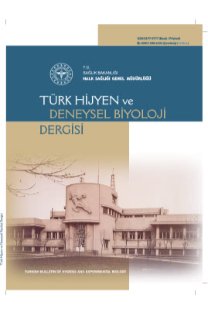Determination of microbiological characteristics of several kinds of ready-to-eat meals presented for consumption
Tüketime sunulan çeşitli hazır yemek ürünlerinin mikrobiyolojik kalitesinin belirlenmesi
___
- 1. Gürgün V, Ayhan K. Gıdalar ve mikrobiyolojik riskler II. Gıda, 1996; 21(3): 159-164.
- 2. Çolak H, Ulusoy B, Bingöl B, Hampikyan H, Muratoğlu K. Tüketime sunulan bazı hazır yemeklerin mikrobiyolojik kalitelerinin incelenmesi. Turk Mikrobiyol Cem Derg, 2007; 37(4): 225-33.
- 3. Özkaya FD, Cömert M. Gıda zehirlenmelerinde etken faktörler. Turk Hij Den Biyol Derg, 2008; 65(3): 149-58.
- 4. Bilgin B, Erkan ÜC. Bir Hazır yemek işletmesinde HACCP sisteminin kurulması. Tekirdağ Zir Fak Derg, 2008; 5(3): 268-81.
- 5. Küçükçetin A, Milci S. Staphylococcus aureus ile kontamine olan peynirlerden kaynaklanan gıda zehirlenmeleri. Gıda, 2008; 33(3): 129-35.
- 6. Fidan F, Ağaoğlu S. Ağrı bölgesinde bulunan lokantaların hijyenik durumu üzerine araştırmalar. YYÜ Vet Fak Derg, 2004; 15(1-2): 107-14.
- 7. Afshin J, Reza Z, Saeid S. Microbiological study of cocktail sausage during shelf life. Middle-East J Sci Res, 2011; 7(6): 1056-1056.
- 8. Alyaaqoubi SJM, Sani NA, Abdullah A, Rahman RDA. Microbiological quality of selected ready-to-eat food at Hulu Langat district, Malaysia. Prosiding Seminar Kimia Bersama UKM-ITB VIII 9-11 June 2009, Pp. 422.
- 9. Oranusi US, Braide W. A study of microbial safety of ready-to-eat foods vended on highways: OnitshaOwerri, South East Nigeria. Int Res J Microbiol, 2012; 3(2): 66-71.
- 10. Hosein A, Muñoz K, Sawh K, Adesiyun A. Microbial load and the prevalence of Escherichia coli, Salmonella spp. and Listeria spp. in ready-to-eat products in Trinidad. The Open Food Sci J, 2008; 2: 23-8.
- 11. Anonymous. Guidelines for assessing the microbiological safety of ready-to-eat foods placed on the market. http://www.hpa.org.uk/ webc/hpawebfile/hpaweb_c/1259151921557. 31.12.2013.
- 12. Gürgün V, Ayhan K. Gıdalar ve mikrobiyolojik riskler I. Gıda; 1996; 21(1): 23-9.
- 13. Jacxsens L, Kussaga J, Luning PA, Van der Spiegel M, Devlieghere F, Uyttendaele M. A microbial assessment scheme to measure microbial performance of food safety management systems. Int J Food Microbiol, 2009; 134: 113-25.
- 14. Anonymous. Türk Gıda Kodeksi Mikrobiyolojik Kriterler Yönetmeliği. Ankara: T.C. Gıda Tarım ve Hayvancılık Bakanlığı, 2011.
- 15. Anonymous. Gıda ve hayvan yemlerininmikrobiyolojisi-Salmonella spp tespiti için yatay metot. TS EN ISO 6579, 2002.
- 16. Anonymous. Microbiology of food and animal feeding stuffs -- Horizontal method for the detection and enumeration of Listeria monocytogenes -- Part 1: Detection method. TS ISO 11290-1, 1996.
- 17. Anonymous. Gıda ve hayvan yemleri mikrobiyolojisiBacillus cereus sayımı için yatay metot. 30 OC'de koloni sayım tekniği. TS EN ISO 7932, 2004.
- 18. Anonymous. Gıda ve hayvan yemleri mikrobiyolojisiKoagülaz pozitif stafilokokların (Staphyloccus aureus ve diğer türler) sayımı için yatay metotbölüm 1: Baird-Parker agar besiyeri kullanarak. TS EN ISO 6888-1, 1999.
- 19. Anonymous. Gıda ve hayvan yemleri mikrobiyolojisiCampylobacter spp.'nin sayımı ve belirlenmesi için yatay metot-bölüm I: belirleme yöntemi. TS EN ISO 10272-1, 2006.
- 20. Anonymous. Microbiology of food and animal feding stuffs-Horizontal method for the detection of Escherichia coli O157. TS EN ISO 16654, 2001.
- 21. Anonymous. Microbiology of food and animal feeding stuffs-horizontal method for the enumeration of sulfite-reducing bacteria growing under anaerobic conditions. ISO 15213, 2003.
- 22. Anonymous. Enumeration of Escherichia coli and coliform bacteria. Bacteriological Analytical Manual. 2002.
- 23. Anonymous. Microbiology of food and animal feeding stuffs -- horizontal method for the enumeration of yeasts and moulds -- part 1: colony count technique in products with water activity greater than 0.95. ISO21527-1, 2008.
- 24. Anonymous. Microbiology of food and animal feeding stuffs -- horizontal method for the enumeration of yeasts and moulds -- part 2: colony count technique in products with water activity less than or equal to 0.95. ISO 21527-2, 2008.
- 25. Yalçın H, Can ÖP. Tüketime hazır bazı et yemeklerinin mikrobiyolojik kaliteleri. Erciyes Üniv Vet Fak Derg, 2013; 10(1): 1-6.
- 26. Bostan K, Yılmaz F, Muratoğlu K, Aydın A. Pişmiş döner kebaplarda mikrobiyolojik kalite ve mikrobiyel gelişim üzerine bir araştırma. Kafkas Univ Vet Fak Derg, 2011; 17(5): 781-6.
- 27. Hatakka M. Hygienic quality of foods served on aircraft. Academic Dissertation, Department of Food and Environmental Hygiene, Faculty of Veterinary Medicine, University of Helsinki, 2000.
- 28. Pamuk Ş, Gürler Z, Yıldırım Y, Ertaş N. The microbiological quality of ready to eat salads sold in Afyonkarahisar, Turkey. Kafkas Univ Vet Fak Derg, 2013; 19(6): 1001-6.
- 29. Arıcı M, Gümüş T, Şimşek O. Hazır salataların hijyenik durumu. Gıda, 2003, 28(6): 571-7.
- 30. Ildız F, Çiftçioğlı G. Toplu tüketim amacıyla üretilen gıdaların bazı patojen mikroorganizmalar yönünden incelenmesi. İstanbul Üniv Vet Fak Derg, 1997; 23(2): 405-12.
- 31. Can ÖP, Yalçın H. Mersin'de tüketime sunulan kremalı pastaların mikrobiyolojik kalitelerinin değerlendirilmesi. Gıda Teknol Elektr Derg, 2011; 6(3): 42-8.
- ISSN: 0377-9777
- Yayın Aralığı: 4
- Başlangıç: 1938
- Yayıncı: Türkiye Halk Sağlığı Kurumu
Elif ŞAHİN-HORASAN, Nuran DELİALİOĞLU, Hande KOSTUL, Candan ÖZTÜRK, Gürol EMEKDAŞ, Necdet KUYUCU
Nevriye GÖNÜLLÜ, Fatma ÇAKIRLAR KÖKSAL, Nuri KİRAZ, Kübra CAN, Seval ÜRKMEZ, Mert KUŞKUCU, Kenan MİDİLLİ
Yıldırım CESARETLİ, Umut BERBEROĞLU, Havva SARI, Şule ERGÜL ŞENSES, Sevinç ERTAŞ, Hasan IRMAK
Mikolojik klinik tanıda moleküler teknikler
Dilber AKTAŞ, Gül Bahar ERDEM, İpek MUMCUOĞLU, Nilay ÇÖPLÜ, Ayşegül GÖZALAN, Hüsniye ŞİMŞEK
Fehminaz TEMEL, Ali BOZ, Selmur TOPAL, Mustafa Bahadır SUCAKLI, Ali Hasan ZUBAROĞLU, Metin KIZILELMA, Gonca ATASOYLU, Belkıs LEVENT
Tarım çalışanlarının bitki koruma ürünleri konusunda bilgi ve davranışları
İpek atıksularından geri kazanılan serisin proteininin karakterizasyonu
Gökşen ÇAPAR, Seylan Saniye AYGÜN
Semra SOYDAM-AYDIN, Aslı FAZLIOĞLU, Demet CANSARAN-DUMAN, İlker BÜYÜK, Sümer ARAS, Kürşat DERİCİ
